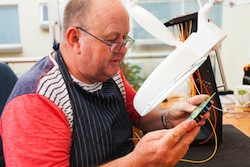Case studies show C. diff symptoms and treatment options
Chapter 1 of C. Diff In 30 Minutes by J. Thomas Lamont, M.D. features stories of four patients who experienced various C. diff symptoms and how they were treated. Their names, identities, and other details have been changed to protect their privacy. The photos are not of real patients.
You, a friend or a family member may have C. diff symptoms similar to Jeannie, Al, Mrs. E, and Martina. While these patients are quite different, they share a few things in common: All were healthy and active before contracting C. diff, but eventually felt that the infection had taken over their lives. The Clostridium difficile infection impacted their health and caused worry for them and family members. The good news is that after treatment all eventually recovered.
The following excerpts describe various C. diff symptoms. To see more symptoms, and to learn how they were treated, purchase or download the book.
Jeannie’s Story: “My stomach feels terrible”
 When I first visited Jeannie in her hospital bed in our obstetric service, she had delivered her firstborn, a healthy 7-pound, 8-ounce boy, six days earlier. Her pregnancy was uneventful, but after she was in labor for 36 hours her obstetrician decided that it was time for a C-section. The surgery was uneventful. However, four days later, Jeannie spiked a fever of 101 degrees from an infection in her incision. Her doctor ordered that she begin taking the antibiotic Ciprofloxacin by vein. After a few doses, the fever dropped and the incision looked better, with less redness and tenderness. At that point, Jeannie was anxious to go home with her new baby.
When I first visited Jeannie in her hospital bed in our obstetric service, she had delivered her firstborn, a healthy 7-pound, 8-ounce boy, six days earlier. Her pregnancy was uneventful, but after she was in labor for 36 hours her obstetrician decided that it was time for a C-section. The surgery was uneventful. However, four days later, Jeannie spiked a fever of 101 degrees from an infection in her incision. Her doctor ordered that she begin taking the antibiotic Ciprofloxacin by vein. After a few doses, the fever dropped and the incision looked better, with less redness and tenderness. At that point, Jeannie was anxious to go home with her new baby.
On the evening prior to discharge, she suddenly took a turn for the worse. Jeannie felt nauseated after supper, and complained of cramps in her left lower abdomen. Her condition quickly deteriorated. She was nauseated and vomiting, and she was passing watery diarrhea every hour. By midnight, she was passing watery stools every 20 or 30 minutes.
To learn more about Jeannie’s story and how she was treated, read the paperback, PDF, or ebook versions of C. Diff In 30 Minutes.
Al’s Story: “My C. diff won’t go away”
 Al was a very healthy 62-year-old electrician. That is, until he developed an abscess on his wisdom tooth. His dentist prescribed the antibiotic clindamycin for seven days to treat the abscess and scheduled a root canal.
Al was a very healthy 62-year-old electrician. That is, until he developed an abscess on his wisdom tooth. His dentist prescribed the antibiotic clindamycin for seven days to treat the abscess and scheduled a root canal.
Five days after Al finished the clindamycin, he developed diarrhea, an upset stomach, and pain in the lower abdomen. The diarrhea was severe, occurring up to 10 times per day. He called his doctor who tested his stools for C. diff. The result was positive. Treatment was started with 10 days of Flagyl (one of the same antibiotics taken by Jeannie) four times per day. By the fifth day, his diarrhea was almost gone and Al was ready to go back to work.
Four days later the diarrhea returned. It was as bad as it had been in the beginning. This time, Al’s doctor started him on Vanco (the other antibiotic taken by Jeannie) four times per day. Again, Al appeared to recover, and the diarrhea went away. But eight days after Al stopped the Vanco, it came back — the same smelly diarrhea with lots of mucus and cramps. Al was frustrated now and worried that he might never get rid of his C. diff.
Read the rest of Al’s treatment history in the paperback, PDF, or ebook versions of C. Diff In 30 Minutes.
Mrs. E: “Do you think I will ever be rid of this awful C. diff?”
 Mrs. E was a feisty 80-year-old grandmother living alone in her home with two cats and a canary. She came to my office because she wasn’t sure her C. diff was gone.
Mrs. E was a feisty 80-year-old grandmother living alone in her home with two cats and a canary. She came to my office because she wasn’t sure her C. diff was gone.
Her story started three months earlier, after she had a knee replacement. During her recovery, she developed a fever and received the antibiotic Cipro for just three days. A week after discharge, she got a C. diff infection while staying in a rehab hospital. After a week of diarrhea, her doctor tested her stool for C. diff. When the test came back positive, she was started on Flagyl, the same antibiotic taken by both Jeannie and Al. Her response was excellent, and five days later she was no longer having any diarrhea.
After Mrs. E had finished the Flagyl and was back home again, she visited her doctor who decided to test her stool for cdiff to see if it was gone. To his surprise and to Mrs. E’s disappointment, the test came back positive.
Read the rest of Mrs. E’s story in the paperback, PDF, or ebook versions of C. Diff In 30 Minutes.
Martina’s Story: “My C. diff is gone, so why do I still have diarrhea?”
 Martina, a schoolteacher in a suburb of Boston, got C. diff when she was hospitalized for pneumonia. First, she caught a cold from one of her fifth-graders. A few days later, she spiked a fever, and felt short of breath. A chest x-ray in the emergency room showed right lower-lobe pneumonia. She was admitted to the hospital for three days and quickly responded to treatment with Levaquin (levofloxacin), a strong antibiotic used to treat pneumonia and other infections.
Martina, a schoolteacher in a suburb of Boston, got C. diff when she was hospitalized for pneumonia. First, she caught a cold from one of her fifth-graders. A few days later, she spiked a fever, and felt short of breath. A chest x-ray in the emergency room showed right lower-lobe pneumonia. She was admitted to the hospital for three days and quickly responded to treatment with Levaquin (levofloxacin), a strong antibiotic used to treat pneumonia and other infections.
C. diff diarrhea started a week after she was discharged. The infection responded quickly to a 10-day course of Vanco. She felt well, except for one or two loose stools in the morning, with gas and bloating. A month after she had pneumonia, her stools were still not back to normal, so she asked her doctor if she could be tested again for C. diff. A stool test for C. diff was negative, but Martina was still worried that her infection was back.
Over the next few weeks her diarrhea increased to three or four mushy or watery stools daily, with more gas and bloating. She gave up spicy foods and coffee, and went on a lactose-free diet. None of these actions helped very much.
To make matters worse, the diarrhea was coming on without much warning, so she felt she had to stay close to the bathroom, especially in the morning. One day she had a near accident in her classroom, barely making it to the bathroom. That’s when Martina decided she needed another opinion.
Read the rest of Jeannie’s story in the paperback, PDF, or ebook versions of C. Diff In 30 Minutes.